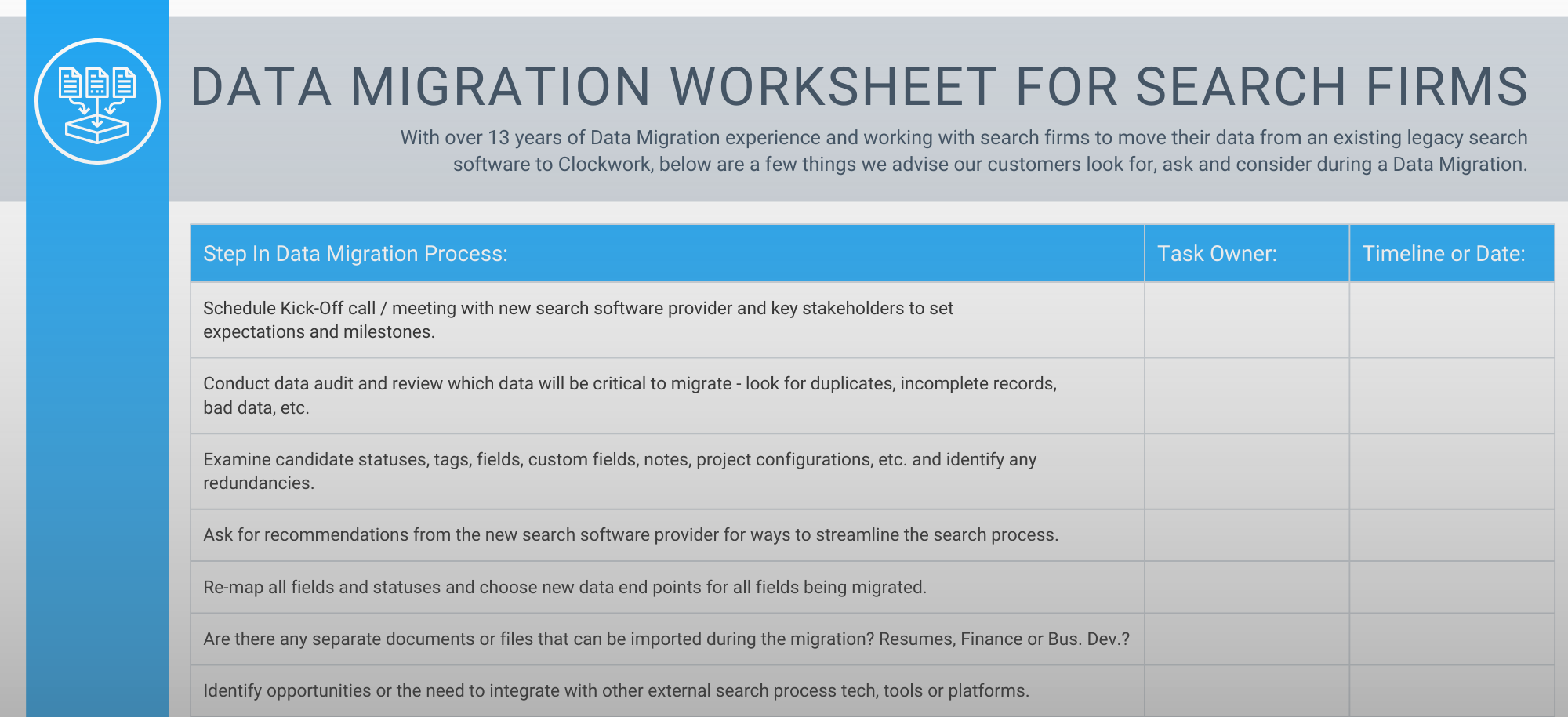5 Key Things To Consider During A Data Migration to a New Recruiting CRM

Adopting new technology is an exciting opportunity for any firm. But, when it comes to evaluating executive search software, there are many things to consider before you even get to a final decision.
Once you’ve short-listed the best options for your firm, it’s time to think about how you're going to migrate data into your firm's new executive search CRM.
What most firms don’t realize is that a data migration for your executive search crm is a rare opportunity to clean-up, enrich, remove, and streamline all the data you've collected over time: people, companies, deals, projects, tags, statuses and more. Whether you're migrating a million candidate records from a legacy system, or getting your first recruiting software up and running, we have compiled our best practices built from running hundreds of data migrations to help you maximize every ounce of your data migration.
Recruiting software runs best off fresh, cleaned up data
Think about how much more productive you are when you've got a clean, organized desk. The same thing goes for your recruiting CRM. Your new software should be fueled and run by the best version of your data. So, when preparing to run a data migration into your new recruiting CRM, look carefully at your existing data and identify any candidates, projects, people or even companies that have not been updated in years. Take it a step further and have your new recruiting software partner run a data audit for various objects and assets within your existing database to get a 360 view of your data. What data points or fields, if any, are empty or missing critical details like email addresses, phone numbers, and LinkedIn profiles? If contacts are missing specific data, work with your search software to decide whether or not it's worth moving. Adopting a new executive search CRM will be transformative for your search business and process, and you should focus on bringing the most valuable and usable data with you. Clockwork offers data migration services to all our clients, because we believe deeply in the power of fresh, clean data. Here's a worksheet to help you prepare for any data migration.
Streamline your data processes to eliminate redundancies
When it comes to booting up your new recruiting CRM, it's important to remember that data imports and data migrations are not the same. A data import will take everything (and we mean everything) from a legacy system and move it over to your new system. Chances are you’ve been using your legacy recruiting CRM for a while, which means years of duplicate records and redundancies in statuses, tags, fields, and much more. So if you only focus on importing your data, you're bringing all the bad stuff along with you.
By focusing on a data migration, you can use this opportunity to truly streamline your entire recruiting process. Is there a way to combine any of your statuses or tags? Have some members of your team been tracking data differently than others? Do you have a clear naming convention for your data points? Here's an example: instead of having multiple variations of the same tag such as: Fintech, fin_tech, tech-finance, fin-tech, Ftech, etc., your data migration is the perfect time to merge all of these tags into one simple “FinTech” tag. The same is true for candidate and project statuses. Putting in the effort during a data migration not only cleans up your search data but creates a new framework for how your team should be organizing, using and leveraging your data.
Breakdown siloes to create a single source of truth
As you grow your business, it's natural for your processes, systems and general workflows to evolve. Where this can get you into trouble is when everyone on your team starts using different processes, systems and workflows. As soon as work becomes siloes, every day you're moving further and further away from running truly effective executive search practices.
Migrating data into your new recruiting CRM provides you with the perfect opportunity to truly evaluate where your data, processes and workflows live. If they're all over the place, now is the time to do some cleanup. Your business development, outreach, research, strategy and sourcing all require your whole team to be on the same page; and without a single source of truth in both your process and data, your team will be operating in chaos.
Refresh and update your People and Company data
In prepping to migrate to your new recruiting CRM, now is the perfect time to update and refresh your data. Check with your new software provider to see if they have data enrichment services, or recommended tools to help you build richer, more complete profiles for the people and companies in your database. Whether you chose to enrich your entire database, or prioritize certain segments such as key talent pools or select companies, make sure to explore data enrichment as a part of your data migration strategy.
Choose and Communicate A Launch Date
After all this prep, there is one huge thing that can derail your upcoming migration to a new recruiting CRM... if key people on your team don't know it's happening. Make sure to communicate across your whole team that you're making changes to company technology infrastructure, and use this as an opportunity to source any potential roadblocks in your migration. The last thing you want is having certain team members still using old systems, putting the integrity of your data at risk of duplicates, siloing and inconsistency.
For quality and data integrity purposes, choose and communicate a specific date to your team where they will no longer be able to access or use the legacy search software system. This date should be shortly following your completed Data Migration to ensure no new data or records get created in your former system.
We know that when it comes to data migration, there is a lot to think about. We've compiled the key steps every search firm needs to complete when migrating data to a new CRM in this Data Migration Worksheet. Whether you're making the switch to using Clockwork's recruiting CRM, or another executive search tool, use this worksheet to get your whole team on the same page, ensure you're covering all your bases, and go through the steps to make your migration a success.
The Eight Stages of Successful Retained Search
- Intro to the Eight Stages of Successful Retained Search
- A.I.'s Future Impact On The Executive Search Process
- Search Firms Are Divided If A.I. Can Intelligently Source and Assess Finalist Candidates
- Search Firms Believe A.I. Will Have Little Impact On Final Stages Of A Search.
- Search Firms See A.I. Supplementing Most Of Their Marketing Efforts
To learn how The 8 Stages of Successful Retained Search are incorporated and supported in Clockwork, read our support documentation. To see it in action, view this playlist of videos.
Thaddeus Andres
With nearly 13 years of experience within executive search and recruitment, Thaddeus has held several marketing roles at various industry associations, networks and companies where he was responsible for implementing, leading and driving key marketing strategies and initiatives.

